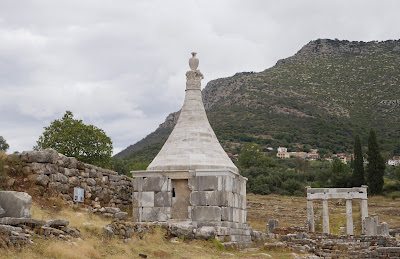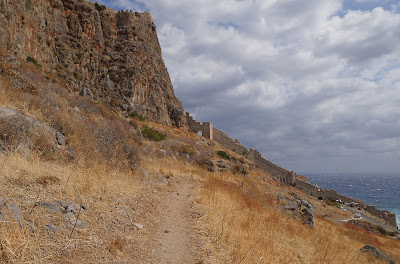Messene wasn't on our radar when we planned our trip to the Peloponnese, but we saw a lovely photo of a what seemed to be a small temple on the site and decided to visit it on our way back to Athens. Ancient Messene turned out to be about 20 km north of modern Messini on the edge of a village called Mavromati. Messene was founded in the 3rd century BC at the foot of Mount Ithomi and continued into Roman times, being abandoned around 360 AD. As I am writing this I have just discovered that we failed to see a section of the city walls and an ancient gateway. That is really annoying, but there was still a great deal to enjoy.
Our first view revealed a large area with numerous ruined and partly restored structures.
The first main sight was the large, partly restored, Theatre.
The row of columns further down the slope is part of a Stoa along the side of the market place.
Then there is the Sanctuary of Asclepius, the god of healing.
We realised that we hadn't seen our small temple and headed downhill to search for it. We quickly found it at the far end of an astonishing area containing a splendid stadium and gymnasium, nicely restored, surrounded on three sides by a Stoa.
On the right was a totally restored wrestling area.
Now finally we got close to our temple – which we had seen of course as soon as we spotted the stadium. It turns out to be the Mausoleum of the eminent Saithidae family and was in use between the 1st and 3rd centuries AD. It was still a delight to see it in the flesh in a beautiful position with the valley stretching away behind.
Closer inspection revealed that it sits on an astonishingly thick base.
We retraced our steps to the car park and got into the car for the long drive to Athens airport. Our visit to Messene provided a nice note to end our holiday on.
Conditions: greyish, but mild. The rain of the previous couple of days had finally departed.
Rating: five stars.
Rating: five stars.



















































